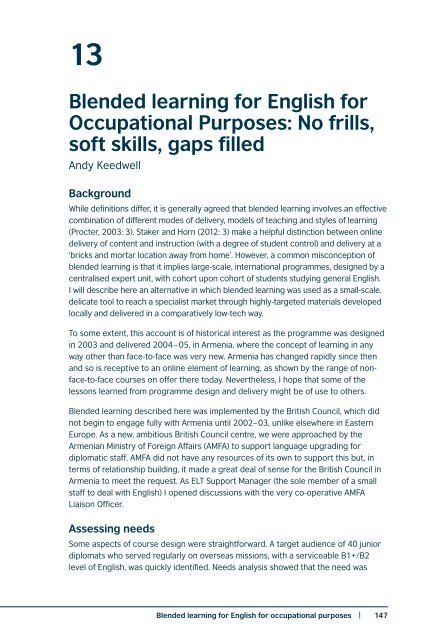Blended Learning in English Language Teaching: Course Design and Implementation
Blended Learning in English Language Teaching: Course Design and Implementation
Blended Learning in English Language Teaching: Course Design and Implementation
You also want an ePaper? Increase the reach of your titles
YUMPU automatically turns print PDFs into web optimized ePapers that Google loves.
13<br />
<strong>Blended</strong> learn<strong>in</strong>g for <strong>English</strong> for<br />
Occupational Purposes: No frills,<br />
soft skills, gaps filled<br />
Andy Keedwell<br />
Background<br />
While def<strong>in</strong>itions differ, it is generally agreed that blended learn<strong>in</strong>g <strong>in</strong>volves an effective<br />
comb<strong>in</strong>ation of different modes of delivery, models of teach<strong>in</strong>g <strong>and</strong> styles of learn<strong>in</strong>g<br />
(Procter, 2003: 3). Staker <strong>and</strong> Horn (2012: 3) make a helpful dist<strong>in</strong>ction between onl<strong>in</strong>e<br />
delivery of content <strong>and</strong> <strong>in</strong>struction (with a degree of student control) <strong>and</strong> delivery at a<br />
‘bricks <strong>and</strong> mortar location away from home’. However, a common misconception of<br />
blended learn<strong>in</strong>g is that it implies large-scale, <strong>in</strong>ternational programmes, designed by a<br />
centralised expert unit, with cohort upon cohort of students study<strong>in</strong>g general <strong>English</strong>.<br />
I will describe here an alternative <strong>in</strong> which blended learn<strong>in</strong>g was used as a small-scale,<br />
delicate tool to reach a specialist market through highly-targeted materials developed<br />
locally <strong>and</strong> delivered <strong>in</strong> a comparatively low-tech way.<br />
To some extent, this account is of historical <strong>in</strong>terest as the programme was designed<br />
<strong>in</strong> 2003 <strong>and</strong> delivered 2004 – 05, <strong>in</strong> Armenia, where the concept of learn<strong>in</strong>g <strong>in</strong> any<br />
way other than face-to-face was very new. Armenia has changed rapidly s<strong>in</strong>ce then<br />
<strong>and</strong> so is receptive to an onl<strong>in</strong>e element of learn<strong>in</strong>g, as shown by the range of nonface-to-face<br />
courses on offer there today. Nevertheless, I hope that some of the<br />
lessons learned from programme design <strong>and</strong> delivery might be of use to others.<br />
<strong>Blended</strong> learn<strong>in</strong>g described here was implemented by the British Council, which did<br />
not beg<strong>in</strong> to engage fully with Armenia until 2002– 03, unlike elsewhere <strong>in</strong> Eastern<br />
Europe. As a new, ambitious British Council centre, we were approached by the<br />
Armenian M<strong>in</strong>istry of Foreign Affairs (AMFA) to support language upgrad<strong>in</strong>g for<br />
diplomatic staff. AMFA did not have any resources of its own to support this but, <strong>in</strong><br />
terms of relationship build<strong>in</strong>g, it made a great deal of sense for the British Council <strong>in</strong><br />
Armenia to meet the request. As ELT Support Manager (the sole member of a small<br />
staff to deal with <strong>English</strong>) I opened discussions with the very co-operative AMFA<br />
Liaison Officer.<br />
Assess<strong>in</strong>g needs<br />
Some aspects of course design were straightforward. A target audience of 40 junior<br />
diplomats who served regularly on overseas missions, with a serviceable B1+/B2<br />
level of <strong>English</strong>, was quickly identified. Needs analysis showed that the need was<br />
<strong>Blended</strong> learn<strong>in</strong>g for <strong>English</strong> for occupational purposes | 147


